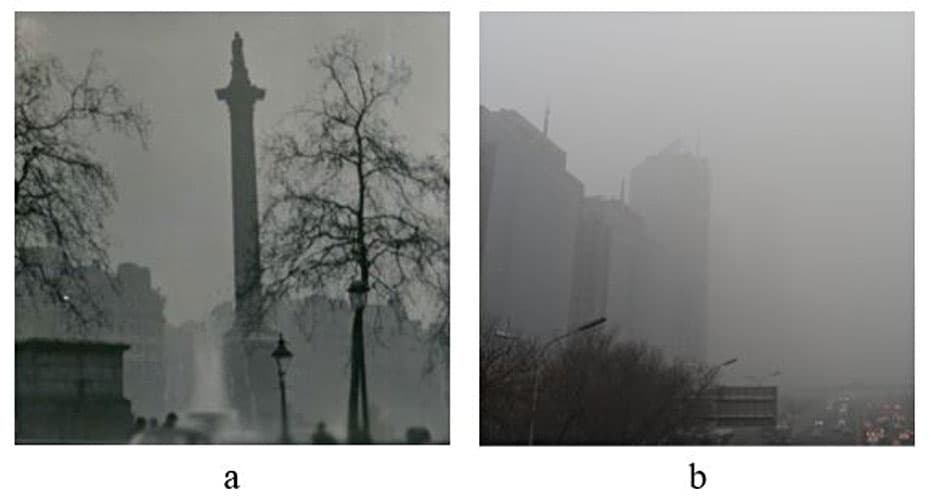Introduction and Rationale
In December of 1952, a fog unlike any other descended upon the city of London. But this fog wasn’t just made up of condensed water droplets. It was full of black particulate matter and sulfur dioxide particles at levels that would be considered astronomical by today’s environmental standards. By the time the fog finally lifted, more than 4000 people had died and more than 100,000 were made ill in what was called the Great Smog of London (Figure 1a). Coal being burned in domestic fire places in the city and in coal-fired power plants in the greater London area produced high levels of pollution, which interacted with the surrounding air and water vapor to form the fatal fog.1 And even though there are much tougher environmental regulations and many developed countries are moving away from coal in favor of cheaper and cleaner natural gas or renewable energies, it still accounts for around 27% of energy production globally. Coal will continue to represent a large portion of the global energy portfolio through 2040 as developing countries turn to it as a cheap and readily available source of energy for their growing economies and populations.2 For these reasons, coal pollution is still an important environmental issue, as demonstrated by intense smog events occurring in northern China as a result of coal combustion to produce electricity (Figure 1b).

Figure 1: a) Smog conditions in Trafalgar Square, London, 1952.3 b) Beijing’s central business district, 2013.4
Because of coal’s staying power it is important for students to be familiar with its severe environmental implications, including the impact of mountaintop removal mining, acid-mine drainage, acid deposition, particulate matter pollution, and mercury pollution. It is also important for students to understand the interconnectedness of the environmental problems associated with coal, and this unit aims to bridge the gap between existing curriculum units on energy use, coal mining, and air pollution through hands-on activities and demonstrations.
School Profile and Course Specifics
William Penn High School is a public high school in the Colonial School District in New Castle County, DE. It is the only high school in the district and is the largest high school in the entire state, serving over 2,000 each year across grades 9-12. The district is considered suburban/urban fringe and serves a diverse population in terms of both race and family income levels. There has been a resurgence in jobs in the district, mostly in the industrial sector. This has created a demand for employees with job-specific skill sets, experience, and certifications. As such, William Penn has focused on the growth of Career and Technical Education programs that provide opportunities for students to experience a vocational-type education while still being provided with the traditional college preparatory education typical of public schools.
Such a shift has allowed the school to retain students who may otherwise attend one of the several area Vo-Tech schools. William Penn also offers 25 Advanced Placement courses, the greatest number of any school in the state. This dual focus on college and career readiness has greatly improved the school culture and the school’s image in the community, which has translated to the growth in the student population. Students entering William Penn chose a degree program to specialize within one of three college academies: Business, Humanities, or STEM. Degree programs within the Business College Academy include Air Force JRTOC, Business Administration, Culinary Arts, Financial Services, and Accounting. Degree programs with the Humanities College Academy include Behavioral Sciences, Communications, Teacher Academy, Legal Studies, International Studies, and Visual and Performing Arts. The STEM College Academy offers degree programs in Agriculture, Allied Health, Computer Science, Construction, Engineering, Manufacturing, Mathematics, and Science. In order to graduate, students must complete three consecutive years of coursework in their chosen degree program.
This growth in student population and interest in the sciences helped me justify the need for adding AP Environmental Science (APES) to the course catalog in the 2016/17 school year. Students enrolled in the Agriculture degree program can now specialize in the Environmental Science pathway, which requires them to take two years of on-level environmental science before enrolling in APES as their capstone course. I am now teaching the course for the fourth year, and this is first year I have a group of students who are in their final year of the Environmental Science pathway. At this point I feel comfortable enough with the course curriculum to identify areas for improvements. One such area of need is in making connections between units. The way the course is written, each topic exists in a vacuum, independent of others. However, the way that students are tested by the College Board requires them to have a more holistic understanding of the inter-related nature of environmental science.

Comments: